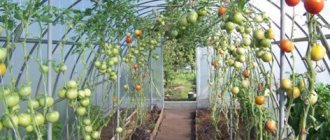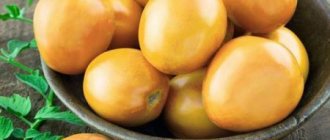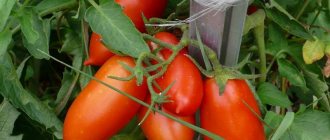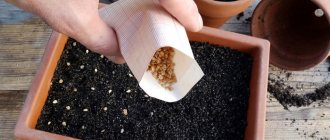Main characteristics of BIF tomato Nina and description of the variety
Tomato Nina belongs to the semi-determinate type
and in most of Russia it is grown only in greenhouse conditions. And only in the south of the country can it be planted in open ground. The Nina tomato is an early ripening variety - no more than 3.5 months can pass from the moment of germination of the seed material to the harvesting of ripe fruits.
Photo of tomato Nina
The bushes are tall, erect, strong, strong shoots can reach 1.7-1.75 m in height. The stems are well leafy, without pubescence. The foliage is typical for tomatoes, narrow, elongated, slightly wrinkled, dark emerald in color.
The Nina variety requires the mandatory formation of bushes
- it is better to leave no more than 2 shoots on each bush. It is also necessary to regularly remove the shoots and tie the bushes to strong supports so that the stems do not break under the weight of ripening fruits.
The first inflorescence appears above the 8-9 leaf, and each subsequent one appears after three true leaves. Small flowers are collected in racemes of complex or semi-complex shape.
Huge ribbed tomatoes. Variety Nina - video
The main advantage of the Nina variety is its large fruits with an unusual ribbed shape.
Cut fruits look beautiful on plates and also in salads. The shape of the fruit is flat-round with clearly defined ribbing. The color of ripe tomatoes is deep red, while the tender, fairly dense and juicy flesh has a crimson color.
Inside the fruit there are several seed chambers with a small number of seeds. The skin of the fruit is of medium thickness, with a slight shine. Tomatoes are not prone to cracking, tolerate transportation well over different distances, and can be stored for quite a long time in appropriate conditions. During transportation and storage, the harvested crop does not lose its original presentation and taste.
Photo inside the Nina tomato fruit
On a note!
The large-fruited nature of the Nina tomato is another advantage of this variety. The weight of the fruit can be 350-400 g, but the first tomatoes can weigh even more - up to 650-700 g. The taste of ripe tomatoes is sweetish with a small amount of acid.
This salad variety looks great when sliced; there are voids in the pulp.
The Nina tomato calmly tolerates temperature fluctuations, while its growth and fruit ripening do not slow down.
Preparation of planting material and propagation
Tomato Nina is a true variety. Seeds from ripened tomatoes can be used for propagation. Since the variety is quite young, planting material should be purchased only from the original company, the seed-growing organization Poisk or from the Partner company.
Seed preparation
Seeds purchased from amateur vegetable growers or collected independently must be subjected to pre-sowing treatment.
Preparation of planting material of the Nina variety:
- disinfection - in a saturated solution of potassium permanganate or any bio-fungicide;
- stimulation of germination (when sowing seeds older than 2 years) - in aloe juice, Epine, Zircon;
- rinsing with clean water and slightly drying the grains until they flow.
Some vegetable growers prefer to pre-germinate any planting material. To hatch the seeds, it is enough to place them between layers of damp cloth for several days. The Nina variety has almost 100% germination, so germination is not necessary for it.
Sowing and growing seedlings
Tomato Nina description of the variety, photos and reports from gardeners are recommended to be grown in seedlings. Although the crop is early ripening, this technique allows you to get a particularly early harvest.
The process of planting and growing seedlings:
- For the Nina variety, you can choose large containers or individual glasses. Tender tomato seedlings develop well in peat cups or tablets.
- The containers are filled with moist substrate and the seeds are laid out on the surface. In common trays, sowing is carried out in rows. Place 1–2 seeds in individual glasses.
- The crops are sprinkled with soil on top, in a layer of up to 1.5 cm. The crops are lightly sprayed and the containers are covered with film.
- Until emergence, containers are kept in a warm place. The best temperature for germination of Nina seeds is from +20 to +25 °C.
- After the first green tomato loops appear, the film is removed. For 5 days, the sprouts are illuminated around the clock or at least 12 hours a day.
- Seedlings can be picked out from a common box at the 2-leaf stage. When replanting, it is recommended to deepen the sprouts to the first leaves.
- Next, the tomatoes will need to be carefully watered and also fed once with a complex product.
Fertilizer for Nina's sprouts can be applied only 10 days after picking. Growing viable seedlings takes a minimum of 50 days. Tomatoes with at least 8 true leaves are considered ready for transplanting. It is advisable that the seedlings already have one flower cluster.
Productivity of tomato variety Nina
This variety belongs to beef tomatoes, and the yield of such varieties is always high.
Fruiting of Nina tomatoes is extended over time - the first fruits ripen in the last ten days of June, and the harvest ends in the second or early third ten days of August.
Tomato Nina. Very tasty large-fruited tomato - video
When growing no more than 3 bushes on one square of area, 18-21 kg of ripe fruits are collected from 1 m2 over the entire summer period. If agricultural practices are followed, at least 5-5.5 kg of ripe tomatoes are harvested from each bush.
EXCELLENT VARIETIES OF TOMATOES!
Tomato Rocket Tomato Kiss Description of Bearpaw tomatoes
Diseases and pests
The originators of the variety say that this tomato has good immunity and is practically not affected by diseases characteristic of other tomato varieties.
Photo of bushes with tomatoes of the Nina variety
In particular, the Nina tomato does not suffer from blossom end rot, tobacco mosaic virus and Alternaria blight.
But still, for prevention purposes, the bushes should be treated with fungicidal preparations several times a season.
You should also periodically inspect the bushes for pests. If they are found, then appropriate insecticides must be used for treatment. Any treatments of tomato bushes should be stopped a couple of weeks before harvest, since these drugs are not immediately removed from the fruits and vegetative mass.
Care
No special care is required for this variety. During the growth process, the bush should be formed into 1 or 2 trunks, removing the stepsons. To avoid falling and bending of the trunk, it is better to tie the stem using a greenhouse or trellis structure.
Mulching is recommended to prevent weed growth and retain moisture in the soil. To do this, just lay hay on the ground around the plants or sprinkle it with sawdust. Of course, we must not forget about timely watering. The types of tomatoes in question do not like excess moisture, so they should not be watered abundantly.
They also need feeding 2-3 times a season. During the growth period, nitrogen or organic fertilizers are applied, and when tomatoes begin to ripen, phosphorus and potassium fertilizers are applied.
It is also important to protect plants from pests.
Advantages and disadvantages
The main advantages of the Nina tomato variety include:
- high productivity and extended fruiting;
- large-fruited and original appearance of tomatoes;
- immunity to most diseases characteristic of tomatoes;
- the variety is able to tolerate low temperatures without harming the growth and development of fruits;
- The Nina tomato can be grown in greenhouses and film greenhouses, as well as in beds in the garden.
Interesting article:
Why the leaves of tomatoes in a greenhouse dry out and turn yellow.
The disadvantages should be noted:
- high growth of shoots, so low greenhouses and hotbeds are not suitable for growing them;
- the need to form and garter bushes, as well as regular pinching.
But experts note that this tomato has much more advantages than disadvantages.
Errors during cultivation
The reason for poor growth of Nina tomato bushes, poor flowering and fruiting may be non-compliance with the rules of agricultural technology:
- using expired seeds and sowing them in heavy, poor or infected soil;
- keeping crops in darkness, cold, without regular watering and ventilation, which leads to the development of weak and yellowed sprouts;
- transplanting to a garden bed without preliminary hardening, as a result of which the seedlings wither and die;
- dense plantings, when the bushes suffer from a lack of moisture, nutrients and oxygen, which leads to the development of diseases and causes poor yields;
- violation of the regime of watering, fertilizing, lack of loosening, weeding, preventive treatments;
- Without forming a bush, it is unlikely that you will be able to get large, juicy and tasty fruits.
Growing tomato Nina: from seedlings to planting in open ground and greenhouse
To obtain high yields from this variety, it is necessary to provide it with special care, as well as to properly grow the seedlings.
It is optimal to plant Nina tomato seed material in the second ten days of March. Moreover, you can plant pre-soaked seeds, but you can also sow them dry - they still germinate at about the same time.
Photo of tomato seedlings Nina
But for better plant growth in the future, it is recommended to keep the seed material in a solution of special nutritional preparations before planting. You can also use ash solution for this - 4 tbsp. l. wood ash is diluted in 2 liters of hot water. This solution should be infused for a couple of days.
It is better to immediately plant the seed material in separate containers, so as not to further injure the plants during the diving procedure. Soil for planting can be purchased at gardening stores or prepared at home. To do this, river sand is mixed with humus, and there should be more sand. To make the soil looser, you can add chopped sphangnum moss to it.
Growing beef tomatoes in a greenhouse - video
After planting, the containers are covered with polyethylene and placed in a warm place for germination. Usually the first shoots appear after 6-8 days.
After this, the polyethylene is removed, and the containers with Nina tomato seedlings are placed in a well-lit place. In the first days, the temperature in the room must be lowered so that the seedlings harden. Then the containers are transferred to a warmer place with a temperature of at least 21-22 degrees Celsius.
THE BEST VARIETIES OF TOMATOES!
Tomato The Pride of Siberia Tomato Argonaut Tomato King of the Giants
If the seedlings have sprouted too thickly, then they should definitely be pruned. Water the plants first. Each plant is carefully removed from the soil, trying not to damage the roots. The central root is pinched to stimulate the growth of lateral roots. Then the plants are transplanted into another container, deepening them to the first leaves. The soil is compacted and the containers are moved to a shaded place.
Watering of pruned seedlings is carried out 2-3 times a week.
10-12 days before transplanting tomatoes to a permanent place, they begin to harden them, taking them out into the air for a short time. But gradually the period of stay of plants outside is increased.
Photo of transplanting tomato seedlings
Nina tomato seedlings are transplanted into open ground garden beds in mid-May.
Seedlings can be planted in the greenhouse earlier - in the last days of April.
The distance between neighboring tomatoes in rows is 0.5 m, and the row spacing is 0.4 m. 3-4 plants should be planted on each square of area.
Features of growing seedlings
Tomato seedlings in pots indoor
Seedlings of any plants require attention and timely care. Strong, healthy seedlings are the key to a stable and high harvest. Nina tomatoes are no exception.
Seed preparation
Any seeds require attention before planting.
Attention!!! Planting material must be disinfected to avoid early diseases.
Disinfection of seeds can be done with improvised means. Before processing the seeds, you need to check which ones are suitable for germination. This can be done in a simple way: Place the entire contents of the bags in a container of water and collect only those seeds that sink to the bottom. If some of them float to the surface, these are seeds unsuitable for planting.
At the next stage, you need to start treating diseases that can persist on the seed for a long time. There are several methods for this:
- Zelenka. The most popular antiseptic, it allows you to rid seeds of various diseases. The solution is prepared at the rate of half a teaspoon per 100-150 ml. boiled water. The seeds are dipped into the prepared solution for half an hour, then taken out, dried and planted.
- Potassium permanganate. With the help of manganese you can get rid of all negative bacteria. For disinfection, a dark pink solution is made and the seeds are soaked in it for 15-20 minutes.
- Powdered mustard. For a quarter teaspoon of powder, take a glass of warm water and soak the seeds in it for 3-4 hours.
- Fitosporin M is a popular biological drug used for all common diseases. For antiseptic treatment, you need to take a quarter of a teaspoon of the drug and dissolve it in a liter of warm water, then leave the mixture for 3 hours. Then place the seed in the solution for 2-3 hours.
- The drug "Maxim" is a special treatment material for seeds. Available in liquid form in ampoules. The drug is used in strict accordance with the instructions.
Simple methods of seed treatment can protect future seedlings from most diseases.
Priming
Before planting, the soil, like the seeds, must be treated.
Important!!! Regardless of whether you use soil from a garden plot or a purchased version, it may contain various diseases and insect larvae. Soil treatment is mandatory.
Land cultivation takes place in two stages:
- Calcination. The soil must be calcined in the oven. To do this, place the soil in small portions on a baking sheet and put it in the oven for 10 minutes at 250C.
- Disinfection. Antiseptic soil preparation can be carried out in several ways:
- Potassium permanganate. For processing, you need a slightly pink solution, which you need to water the soil before planting the seeds.
- "Trichodermin." The watering agent is prepared at the rate of 1g. For 1 liter of soil.
- "Fitosporin". The irrigation solution is prepared at the rate of 6 ml. for 10 liters of water.
Capacity
It is convenient to grow Nina tomato seedlings in peat containers. They do not require disturbing the root system when planting them in a permanent location.
Important!!! The root system of tomatoes is very fragile and can be easily damaged during diving. Transplantation must be extremely careful, preferably by transshipment.
Peat containers are made of natural decomposing materials, which allows seedlings to be planted in a permanent place of growth in the future, immersing them in the hole along with the pot.
You can plant seeds both in separate containers and in common containers. It is important to follow the planting pattern.
Planting scheme
When sowing seeds in a common container, you must maintain a distance. So between each seed there should be a distance of at least 1 sq. cm. It is also important to plant the seeds 1 cm from the edge of the container. The container must have drainage holes to avoid retaining excess liquid.
Further care for the Nina tomato variety
Since this variety is demanding on soil moisture, it is recommended to provide drip irrigation in the beds with Nina tomato. In this case, the soil will not become waterlogged, and each plant will be provided with a sufficient amount of moisture.
INTERESTING!
Varieties of black tomatoes
After watering, the soil around the bushes is loosened, while removing weeds. To ensure that moisture evaporates more slowly, it is recommended to add a layer of mulch to the root zone of tomatoes. Straw or grass can be used as a mulching element.
Important!
It must be remembered that these tomatoes require mandatory shaping, removal of stepsons and tying to strong supports. It is necessary to carry out pinching once every 1-1.5 weeks.
How to feed tomatoes Nina
Tomatoes of this variety require regular feeding to form large fruits. Typically, mineral complex fertilizers are applied to tomatoes at least three times during the season. But you can also add organic matter – greenfinch or mullein – under Nina tomatoes.
All tomato fertilizing is done in liquid form immediately after watering.
Care requirements
All further care of the garden bed is simple and comes down to a few standard activities.
In the first days, Nina tomatoes require protection from the sun during the day and from the cold at night. Therefore, they are covered with agrofibre during the day or with film at night.
Watering
The first moistening is carried out a week after transplanting the tomatoes into the garden bed. All subsequent waterings are necessary as the soil dries out. Watering is important at the stage of blooming flowers and filling fruits, which improves the quality of flowering and improves the taste of the fruits. Water is poured at the root to avoid rotting and burning of stems and foliage.
After watering, the soil is loosened and weeded between the rows. To protect against drying out, the stems are covered with garden soil after each loosening.
Feeding
Tomato responds positively to fertilizing with organic and mineral fertilizers. 3 weeks after transplanting the bushes, the plants are watered with a urea solution - 15 g are dissolved in a bucket of water. Consumption per bush – 200 ml.
Before flowering and during the filling phase of tomatoes, add mineral components (superphosphate and potassium - 15 g per bucket of water). 0.5 liters of working fluid is poured under each plant. Additionally, the bushes are irrigated with a solution of boric acid (0.2 g of powder is dissolved in 1 liter of warm water). Spray before and after flowering.
Formation
For this variety, the formation of a bush of 1-2 stems is suitable. In the first case, all stepsons and leaves developing under the flower brush are removed. When forming into 2 stems, the same manipulations are carried out, only one more stepson is additionally left above the flower brush.
Tomatoes need to be properly cared for
As they develop, tall tomato bushes need staking, which will protect the stems from breaking off under the weight of the fruit.
Temperature and humidity
Greenhouse tomatoes require stable heat (20-23 °C) and humidity at 45-60%. On sunny days, ventilation is carried out during the day.
Prevention of diseases and pests
Greenhouse tomatoes are susceptible to rot. To avoid this, it is necessary to prevent waterlogging of the soil, regularly loosen the soil and weed it between the rows
It is also important to follow the bush planting scheme
To prevent damage to tomatoes planted in open ground and greenhouses by fungal, viral and bacterial infections, they are treated twice with the preparation “Skor”, “HOM” or a solution of copper sulfate. The first treatment is done 3 weeks after transplanting the seedlings to the garden bed, the second – before flowering.
To protect against pests - aphids, spider mites, whiteflies - the row spaces are sprinkled with ash and hot pepper powder. In case of parasites, the bushes are irrigated with an ash-soap solution or infusion of garlic and tobacco.
Among the chemicals that help control pests are “Aktellik”, “Aktara” and “Fufanon”. Treatment is carried out a month before the planned harvest. In case of damage during the fruiting phase, the bushes are removed from the site and burned.
Tatyana Orlova (Vasilidchenko) (candidate of agricultural sciences):
You can treat bushes with insecticides at any stage of plant development, but these treatments must be completed no later than 3 weeks before harvesting the fruits.
Reviews from those who planted Nina tomatoes
Many gardeners have already tried to grow the Nina tomato, reviews of which are presented below.
Ivan, 40 years old, Rostov region: I first saw the seeds of this variety on the Internet a year ago and bought a couple of bags to try. I grew it in seedlings - I didn’t dare to sow the seeds directly into open ground. The seeds have all sprouted! The seedlings grew strong and healthy. There was no particular hassle with growing it. Transplanted to the beds in the garden in mid-May. After transplanting, I cared for the bushes of the Nina variety in the same way as other tomatoes. I just had to form the bushes into two stems (as it was written in the description of the variety). As a result, from each square I collected at least 18 kg of original, beautiful and large fruits.
Elena, 45 years old, Krasnodar region: Last season I decided to purchase seeds of a purely salad variety of tomato. I was recommended a new product - the Nina tomato variety. And “Nina” did not disappoint - the fruits ripened gradually, very large and tasty. As a result, throughout almost the entire summer I had fresh, delicious tomatoes on my table every day. I recommend planting this variety to everyone who loves salad varieties of tomatoes.
Olga, 35 years old, Novosibirsk: 2 years ago we bought a dacha, immediately installed a greenhouse and started growing tomatoes, cucumbers and peppers in it. I conduct experiments and buy many varieties of vegetables; this summer I grew Nina’s tomato, among others. A very worthy variety, with good taste characteristics. I recommend!
This tomato variety can be grown both in greenhouse conditions and in open ground, but manufacturers still recommend a greenhouse to obtain the best Nina tomato yields.
Thanks to its main advantages - good yield, large fruit, original appearance of the fruit - the Nina tomato already has its adherents among vegetable growers from different Russian regions. The seeds of this new product can be purchased on the seed market via the Internet from the agricultural company Partner, and they are also available for sale in specialized stores.
Transplantation into the ground
A good time to transplant tomato seedlings Nina is mid-May. If you plan to grow in greenhouse conditions, then planting in a permanent place can be done earlier.
When planting tomatoes in your garden plot, you should follow some rules that will help you get a stable harvest.
Transplanting to a garden bed
It is necessary to plant tomatoes in the garden when the threat of return frosts has passed.
Attention!!! The ground temperature should warm up to 10C, only then you need to transplant the tomatoes into open ground.
For planting in open ground, it is recommended to choose a sunny place, since Nina tomatoes are heat-loving and will not feel comfortable in the shade.
Preparing the site
Before picking Nina's seedlings, you need to prepare the place in advance. To do this, first of all, you should fertilize the soil. You can fertilize the soil using humus. The soil for future tomatoes is mixed with humus. Tomatoes should be planted a week after applying fertilizer.
Planting scheme
Seedlings should be planted at the rate of 2-3 roots per 1 square meter. m. In no case should it be partitioned, since the plants are very tall and can create shade for each other.







